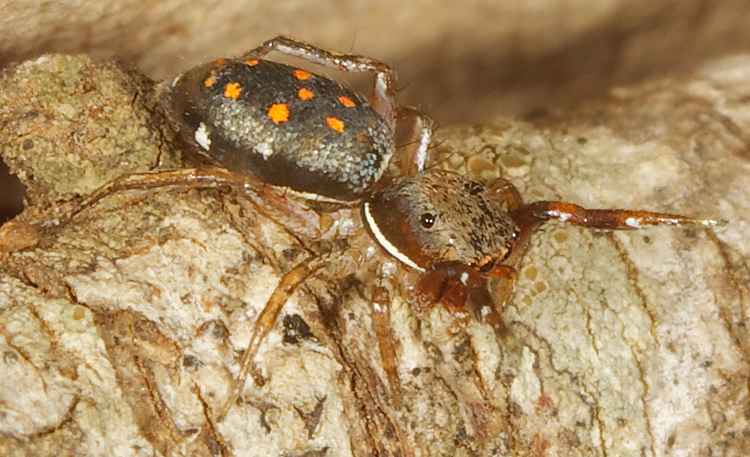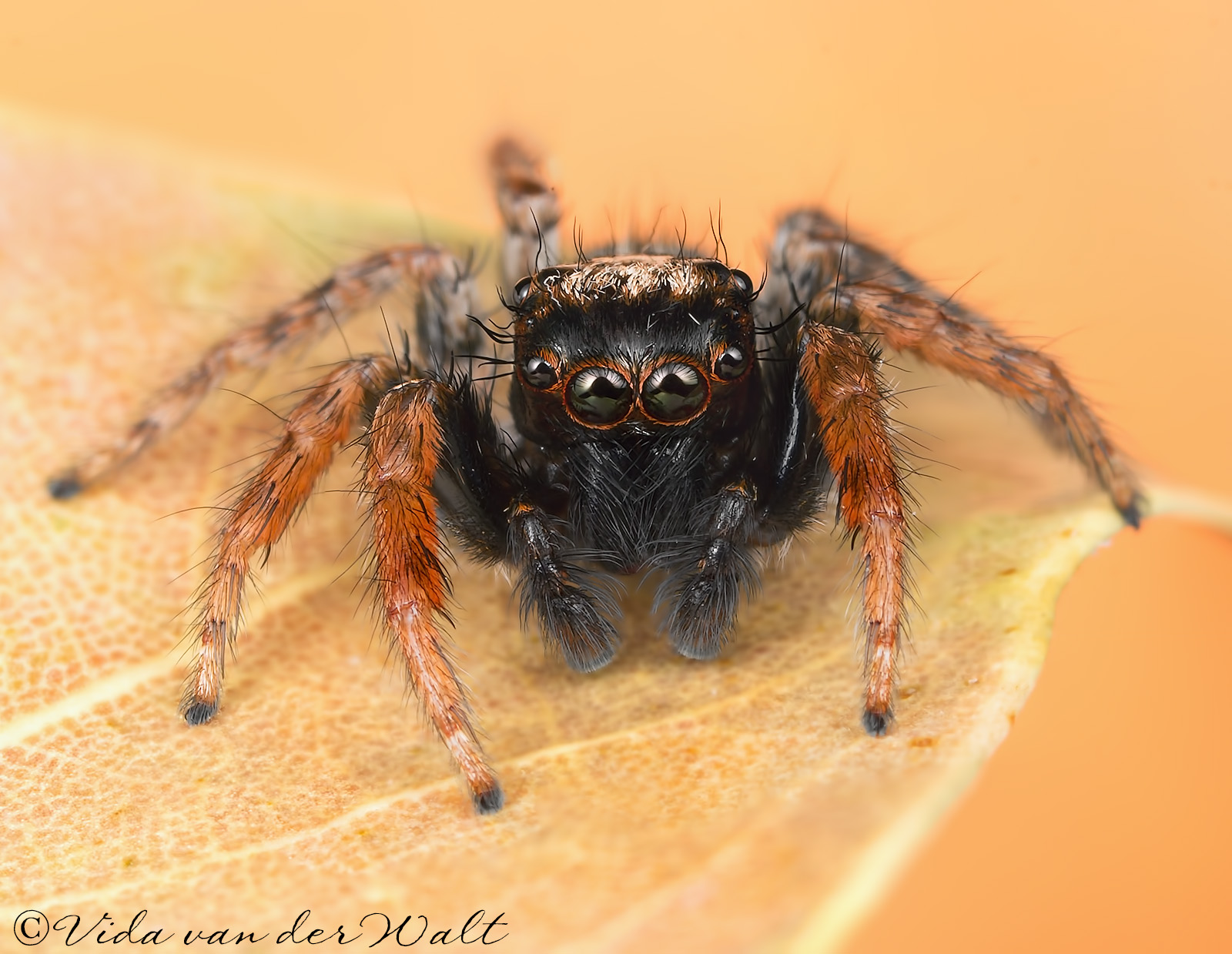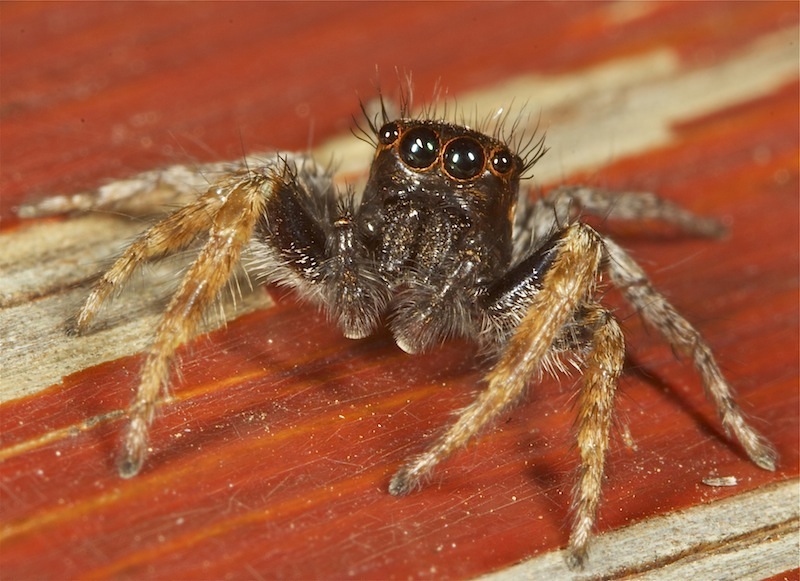I think it's a Stizus and they hunt grasshoppers and maybe mantis.
Insect or Invertebrates Identification - DONE
Moderator: Klipspringer
-
Klipspringer
- Global Moderator
- Posts: 5858
- Joined: Sat Sep 14, 2013 12:34 pm
- Country: Germany
- Contact:
Re: Insect or Invertebrates Identification
I think it's a Stizus and they hunt grasshoppers and maybe mantis.
- Lisbeth
- Site Admin
- Posts: 65757
- Joined: Sat May 19, 2012 12:31 pm
- Country: Switzerland
- Location: Lugano
- Contact:
Re: Insect or Invertebrates Identification
We must send some to Eastern Africa; they are invaded by locusts eating ALL their crops etc. and this in the middle of the Covid-19 crisis 
"Education is the most powerful weapon which you can use to change the world." Nelson Mandela
The desire for equality must never exceed the demands of knowledge
The desire for equality must never exceed the demands of knowledge
Re: Jumping Spider IDs and Comments
Both taken in Kruger in Sept.
Specimen 1

Specimen 2


Those two different j. spiders appear to both be Natta horizontalis according to both this Google Images search:

and this section of the post in the link below:
1. To separate N. horizonatlis and N. chionogaster with confidence, a microscopic examination of their copulatary organs is indicated
2. Failing the above, a less certain separation can be made by comparing the dorsal abdominal markings: Males and females of N. horizontalis have bold, usually rounded orange to red dots on their abdomen. In some cases the dots fuse to form a reticulate pattern. Contrastingly, the markings on the N. chionogaster abdomen are, as Wesolwska ventures, "delicate". The yellowy freckles are smaller and fainter than the bold, more clearly defined 'painted' marks of N. horizontalis.
3. Vida's images of "Natta sp." I believe, are the only colour photographs of N. chionogaster on the interweb, Compare Vida's female Natta horizontalis with her female Natta sp. (which I suggest is a good example of N. chionogaster) as examples of extreme opposites.
https://www.ispotnature.org/communities ... long-story
https://www.jumpingspiders.co.za/gallery.html#n-link
*************************
Comments please.
Specimen 1

Specimen 2


Those two different j. spiders appear to both be Natta horizontalis according to both this Google Images search:

and this section of the post in the link below:
1. To separate N. horizonatlis and N. chionogaster with confidence, a microscopic examination of their copulatary organs is indicated
2. Failing the above, a less certain separation can be made by comparing the dorsal abdominal markings: Males and females of N. horizontalis have bold, usually rounded orange to red dots on their abdomen. In some cases the dots fuse to form a reticulate pattern. Contrastingly, the markings on the N. chionogaster abdomen are, as Wesolwska ventures, "delicate". The yellowy freckles are smaller and fainter than the bold, more clearly defined 'painted' marks of N. horizontalis.
3. Vida's images of "Natta sp." I believe, are the only colour photographs of N. chionogaster on the interweb, Compare Vida's female Natta horizontalis with her female Natta sp. (which I suggest is a good example of N. chionogaster) as examples of extreme opposites.
https://www.ispotnature.org/communities ... long-story
https://www.jumpingspiders.co.za/gallery.html#n-link
*************************
Comments please.
-
Klipspringer
- Global Moderator
- Posts: 5858
- Joined: Sat Sep 14, 2013 12:34 pm
- Country: Germany
- Contact:
Re: Jumping Spider IDs and Comments
Field Guide to South African Spiders, Ansie Dippenaar-Schoeman - 2014
But I doubt that the number of spots is the tell tale
But I doubt that the number of spots is the tell tale
-
Klipspringer
- Global Moderator
- Posts: 5858
- Joined: Sat Sep 14, 2013 12:34 pm
- Country: Germany
- Contact:
Re: Jumping Spider IDs and Comments
Another publication:
Does not help!New species and new records of jumping spiders (Araneae: Salticidae) from central South Africa - 2011
Charles R. Haddad and Wanda Wesołowska
Genus Natta Karsch, 1879
Type species: Natta horizontalis Karsch, 1879.
This African genus includes only two species. The body is dark with a blue metallic shine and a few pairs of glaring orange patches on the abdomen. Copulatory organs of both sexes resemble those of Phintella species.
Natta chionogaster (Simon, 1901)
Habitat and biology: This species is usually found in the vicinity of foraging ants, especially Anoplolepis custodiens F. Smith, which it mimics in its movements and metallicscales on the body. In central South Africa it is clearly less common than N. horizontalis Karsch, 1879.
Natta horizontalis Karsch, 1879
Distribution: Widespread in the Afrotropical Region. In South Africa known from the Gauteng, Mpumulanga and KwaZulu-Natal provinces, recorded here from the Free State and Northern Cape provinces for the first time (Fig. 114).
Habitat and biology: As for N. chionogaster above.
-
Klipspringer
- Global Moderator
- Posts: 5858
- Joined: Sat Sep 14, 2013 12:34 pm
- Country: Germany
- Contact:
Re: Jumping Spider IDs and Comments
From FB The Spider Club of Southern Africa
What I see here is, these people went with the yellowish spots as the distinguishing feature
..............................................Cecile Roux
Visual Storyteller · 4. Januar 2018
Found my ant mimicking Salti again in the garden in Upington. Now convinced it is Natta chionogaster. Very excited about this find. They are so very small, and very pretty!
...............................................Mark Spicer
30. Januar 2018 ·
Another small addition to our jumping species, if this is indeed Natta chionogaster
Nr Alldays, Limpopo
..............................................................Michael De Nysschen
16. November 2016
Found this one in leaf litter and near foraging ants....there were many many of this Salti.
Salticidae Natta Chionogaster
Elize Vega Eveleigh Letsibogo Game Farm.
9. Mai 2017 · Bela-Bela, Limpopo
The only photo I could get of this ant mimicking spider. Correct me if I am wrong, but I would say this is Natta chionogaster
What I see here is, these people went with the yellowish spots as the distinguishing feature
-
Klipspringer
- Global Moderator
- Posts: 5858
- Joined: Sat Sep 14, 2013 12:34 pm
- Country: Germany
- Contact:
Re: Jumping Spider IDs and Comments
My 2 cents:
the first one is a female N. chionogaster (Yellow-spot Natta) and the second one a male N. horizontalis (Red-spot Natta).
How about labelling them Natta cf. chinogaster and Natta cf. horizontalis for the book?
You must decide, ExFmem
Honestly, there is almost no difference in colour
the first one is a female N. chionogaster (Yellow-spot Natta) and the second one a male N. horizontalis (Red-spot Natta).
How about labelling them Natta cf. chinogaster and Natta cf. horizontalis for the book?
You must decide, ExFmem
Honestly, there is almost no difference in colour
Re: Jumping Spider IDs and Comments
Yes, the difference in color is negligible, at least to my eyes. I also have found a number of pics on iNaturalist that vary widely in color and # of spots, all ID's as N.horizontalis. The pics I find of N. ch...whatever  are equally unhelpful to me. Will think on it and dig a bit more (downloaded Wesolowska's 1993 paper Notes on Nattas), but have not read it yet.
are equally unhelpful to me. Will think on it and dig a bit more (downloaded Wesolowska's 1993 paper Notes on Nattas), but have not read it yet.
More tomorrow
More tomorrow
-
Klipspringer
- Global Moderator
- Posts: 5858
- Joined: Sat Sep 14, 2013 12:34 pm
- Country: Germany
- Contact:
Re: Jumping Spider IDs and Comments
Meanwhile my thoughts on this one:
It matches very well Vida's spider photos:


The original species description of a male by Peckham:
http://peckhamia.com/editions/Peckham%2 ... Africa.pdf , (do spiders get bald when they are old?) - now I know.
, (do spiders get bald when they are old?) - now I know.
Better go to the original and never trust any field guide I think, the iamage in the fieldguide is Parajotus refulgens.
I think, the iamage in the fieldguide is Parajotus refulgens.
What do you think?
One can see in the photos that the spider is "obscurofemoratus" (having a dark femur).
It matches very well Vida's spider photos:


The original species description of a male by Peckham:
http://peckhamia.com/editions/Peckham%2 ... Africa.pdf
The fieldguide has the same text for description and when I saw it first I was wondering why there are some hairs left around the eyeParajotus obscurofemoratus sp. nov.
Plate XXII, figs. 2-2d. The femur of the first leg is dark and iridescent, in contrast with the other joints.
♂. Length, 6.5-8 mm. Legs 1432, nearly equally stout.
Our specimens are badly rubbed, so that we can form no clear idea of the markings. There are some reddish hairs left around the eyes and on
the cephalic plate. On the sides of the thoracic part are wide bands of white hairs, sharply outlined by black bands above and below, and ending abruptly at the dorsal eyes, while the hairs on the sides of the cephalic part are black. The clypeus is brown and is one-third as wide as the large middle eyes. The falces are long, stout, projecting, brown in color, and have, on the front faces, ridges of long stiff black hairs. The abdomen has some long white and reddish hairs at the front end, and has white bands on the sides. In the middle there seems to have been a band of reddish hairs running backward for two-thirds the length of the dorsum, and behind this are indistinct dark and light chevrons. The sides are more or less streaked. The first legs have the femoral joints dark and iridescent in whole or in part, making a contrast with the other joints, which are much lighter, and this is true in a less marked degree of the second legs. The first and second pairs have fringes of black hairs under the femur and of light yellow hairs under the patella and tibia. The third and fourth legs are light yellow with dark spots.
The palpi are usually dark and are covered with long stiff black hairs.
Better go to the original and never trust any field guide
What do you think?
Re: Jumping Spider IDs and Comments
Re: P. obsurofemoratus - looks good to me. The description is pretty spot on. Yes, Field Guides cause me more confusion than clarification. Mine's abdomen is a bit lighter, but I'm sure there are variations, like in most species. Thank you!
If you'll work that entry up, I'll do the Natta(s), or I can do both if you'd like. You seem to have your plate quite full around here.!
If you'll work that entry up, I'll do the Natta(s), or I can do both if you'd like. You seem to have your plate quite full around here.!





